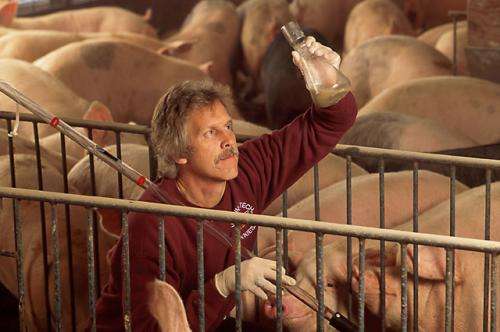Using tree tannins to target manure odor

Tannins from the quebracho tree can control the production of compounds that cause manure odors, according to studies by U.S. Department of Agriculture (USDA) scientists. This research may someday give livestock farmers options for odor control that help protect animal health and restore harmony between rural producers and nearby residents.
The study was done by Agricultural Research Service (ARS) scientists in Peoria, Ill. ARS is USDA's chief intramural scientific research agency.
Hydrogen sulfide and other sulfur compounds make up about half of the offensive odorants from swine manure. Scientists have determined that a group of microbes called sulfate-reducing bacteria generate these compounds as part of the process of breaking down manure. Bacterial activity in manure pits also generates methane and nitrous oxide, which are both greenhouse gases.
Research conducted by scientists elsewhere indicated that tannins-compounds naturally present in tree leaves and other feed materials-can block bacterial activity in the guts of ruminant livestock. Drawing on this research, ARS microbiologists Terry Whitehead and Mike Cotta, who work at the agency's Bioenergy Research Unit in Peoria, conducted a laboratory study to see if quebracho tree tannins could suppress odor-generating bacterial activity in manure.
The scientists incubated swine manure under laboratory conditions that mimic on-farm conditions, which allowed them to monitor gas emissions and sulfate-reducing bacteria populations. Seven days after the researchers added quebracho tannins to the manure, they found hydrogen sulfide and methane production had been reduced more than 90 percent and that production continued to dwindle for another three weeks. Populations of sulfate-reducing bacteria also significantly declined, by 70 percent to 90 percent, in the tannin-enriched mix.
Field studies are now needed to determine if using quebracho tannins in manure pits can significantly reduce the activity of sulfate-reducing bacteria and hydrogen sulfide and methane levels under commercial conditions. If successful, this approach would provide producers with a cost-effective method of mitigating odors and greenhouse gas emissions, and the added tannins would not pose a risk to the environment when the manure is eventually spread onto the fields as fertilizer.
Whitehead and Cotta published their results in the December 2012 issue of Applied Microbiology and Biotechnology.
More information: Read more about this work in the May/June 2014 issue of Agricultural Research magazine.
Journal information: Applied Microbiology and Biotechnology
Provided by Agricultural Research Service

















